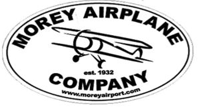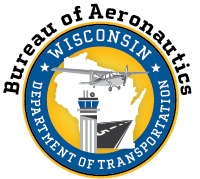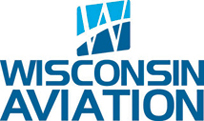by Hal Davis
WisDOT Bureau of Aeronautics
Published in Midwest Flyer Magazine December 2022/January 2023 Digital Issue
Appropriate hangar storage will always be a common point of contention between airports and hangar tenants. Although the Federal Aviation Administration’s (FAA) 2016 policy update on hangar storage added some clarity and common sense to the rules, misunderstandings and disagreements remain. So, let’s talk about hangar storage. What are the rules and who do they apply to? Why do these rules exist and what can be done to avoid problems?

Whether these hangars are owned by the airport or are privately owned, the FAA hangar storage rules apply if the airport has accepted federal airport improvement grants.
Who must comply?
If the FAA inspects an airport that has previously accepted federal airport improvement grants, the expectation is that all hangars, regardless of if they are privately-owned or airport-owned, should be complying with the FAA’s hangar storage policy. However, responsibility for compliance is not that straightforward. By accepting federal airport improvement grants, airport owners agree to comply with the FAA’s hangar storage policy, among other things.
In order to rent a hangar or lease land to build a hangar, a hangar tenant must agree to the terms of a lease with the airport owner. To ensure hangar storage on the airport complies with the policy, airport owners are expected to enter into hangar lease agreements with terms and conditions which perpetuate FAA’s rules. As far as FAA is concerned, it is ultimately the airport owner’s responsibility to comply with the policy. Legally, the hangar lessee only needs to comply with the terms of the lease. Unfortunately, it is not uncommon for a hangar’s use to be in violation of the FAA hangar storage policy, but not in violation of a poorly written or antiquated hangar lease.
There are a small handful of airports in Wisconsin that have accepted state airport improvement grants, but not federal grants. These airports, along with any other airport that has not accepted federal improvement grants, need not comply with the FAA hangar storage policy. Instead, airports which have only accepted state funding must comply with the conditions of state aid listed in Wisconsin Administrative Code TRANS 55. TRANS 55 does not establish any specific requirements as it relates to hangar storage but does establish a general requirement to prohibit any activity which interferes with air transportation. While unprecedented, an airport owner could be found in violation of TRANS 55 if the non-aeronautical use of a hangar is having a significant impact on airport activity.
What are the rules?
As I alluded, I think most people agree the FAA hangar storage policy is common sense and, on the surface, appears uncomplicated. The rules are summarized as follows:
1. * All hangars must be used for a primary aeronautical purpose. FAA considers the following uses aeronautical:
a. * Storage of active aircraft;
b. * Shelter for maintenance, repair, or refurbishment of aircraft, but not the indefinite storage of non-operational aircraft;
c. * Non-commercial construction of amateur-built or kit-built aircraft;
d. * Storage of aircraft handling equipment, (e.g., towbar, glider tow equipment, work benches, tools and materials used to service aircraft);
e. * Storage of materials related to an aeronautical activity (e.g., balloon and skydiving equipment, office equipment, teaching tools).
2. Provided the hangar is used primarily for an aeronautical purpose, an airport may permit non-aeronautical items to be stored in hangars provided they do not interfere with the aeronautical use of the hangar.
3. While airports may develop more restrictive rules, FAA would not consider non-aeronautical storage to interfere with the aeronautical use of the hangar unless the items: 1) Impede the movement of the aircraft in and out of the hangar. 2) Displace the aeronautical contents of the hangar. A vehicle parked at the hangar while the vehicle owner is using the aircraft would not be considered as displacing the aircraft. 3) Impede access to other aeronautical contents of the hangar. 4) Are used for a non-aeronautical business or municipal agency function (including storage of inventory). 5) Are stored in violation of airport rules and regulations, lease provisions, building codes or local ordinances.
4. Hangars cannot be used as a residence. The FAA differentiates between crew rest areas and a hangar residence in that the former are designed to be used for overnight/resting periods for crew members and not as a permanent or even temporary residence.
5. If the airport has empty hangars with no demand for aeronautical use, the airport can rent hangar space for temporary, non-aeronautical storage provided:
a. * The non-aeronautical storage is pre-approved by FAA.
b. * A fair market value commercial rental rate is charged.
c. * The hangar reverts to aeronautical use as soon asthere is demand.
Why do these rules exist?
The purpose of these rules is to ensure bona fide aeronautical users are given the first priority to utilize the airport and the FAA’s investment therein. In other words, having active aircraft in all hangars means more aircraft using the nation’s air transportation system and contributing to the aviation industry. Without this policy, the fear is that hangar tenants will, at best, not put the airport to good use, and at worst, block bona fide aeronautical users from using the airport while at the same time repurposing the public’s investment in the airport for commercial non-aeronautical purposes which could have both safety and ethical concerns.
Common Questions & Issues
Granted, the current FAA hangar storage policy provides much greater clarity than before, but some common questions and issues remain.
First of all, the policy establishes storage of an “active” aircraft as an appropriate use and stipulates the “indefinite storage of non-operational aircraft” is not. What is intended seems black and white at first, but in reality, many situations fall in a gray area. How often does an airplane need to be flown for it to be considered “active?” FAA does not say.
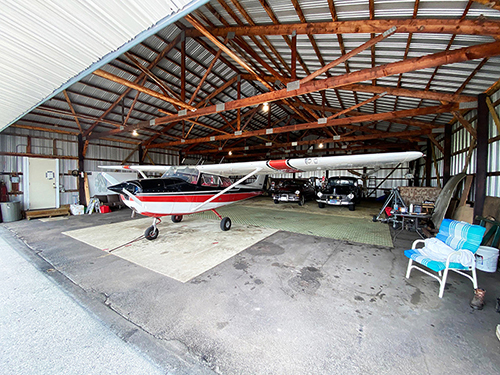
Is this hangar compliant with FAA policy?
Possibly
Is that an “active” aircraft?
Is someone paying the hangar lessee to store the cars?
The hangar storage policy provides airport owners the opportunity to be more restrictive than the policy. Some airports have used this to further define what is considered an “active” aircraft. For example, some airports require hangar tenants to provide proof of a completed annual inspection and/or proof their aircraft is properly registered. These additional requirements can help to weed out “hangar queens” and prevent them from taking up valuable hangar space. However, these requirements also take additional time to track. Unfortunately, this is not a perfect solution to the problem either. Some aircraft types, for example ultralights, don’t always require an annual inspection or registration, yet storage of an “active” ultralight would certainly be considered a proper aeronautical use of a hangar.
A common question is what to do if a hangar owner passes away, loses their medical, or sells their aircraft. How an airport owner can legally address this type of situation will depend on the terms of the lease agreement. However, the goal should be to return the hangar to primary aeronautical use within a reasonable amount of time. That might mean encouraging/requiring a good faith effort to sell the hangar, sublease the space to someone who has an aircraft, or acquire/build a new aircraft. Technically speaking, a completely empty hangar is not a violation of the FAA hangar storage policy until non-aeronautical items are added.
Avoiding Problems
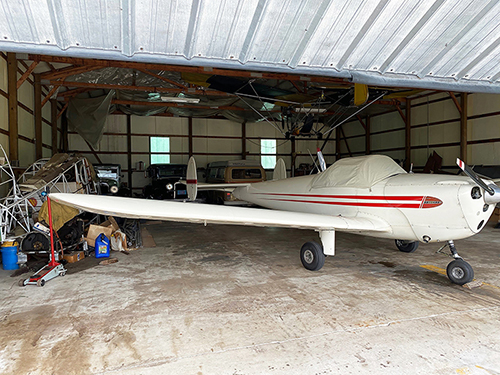
Is this hangar compliant with FAA policy?
Possibly
Is that an “active” aircaft?
Is someone paying the hangar lessee to store the cars?
Avoiding any and all hangar storage problems is improbable. Avoiding the courtroom and being found in noncompliance by FAA are more realistic goals. For an airport, achieving those goals starts with a good understanding of what is written in the lease agreements. Today, most hangar ground leases still predate the 2016 iteration of the FAA’s hangar storage policy by a decade or more. It’s important to take time to identify what deficiencies might exist within the lease language as far as ensuring compliance with the current FAA hangar storage policy is concerned. Does the lease specify the hangar must be used to store an aircraft or other aeronautical items? Is there a requirement that the aircraft be active or airworthy? Does it say anything about storing non-aeronautical items?
If deficiencies are found, there are few different courses of actions to be taken. The easiest thing to do is to address the deficiencies with a new lease template for all new lease agreements going forward. What’s more difficult is addressing existing lease agreements. With the cooperation of the lessee, the airport may be able to amend the current lease as necessary. After all, if the airport is found in noncompliance and loses federal funding eligibility, that will eventually negatively affect hangar tenants as well. If that’s not an option, hangar storage rules can also be codified into a local airport rule or ordinance. Whatever the solution may be, working with the airport owner’s legal counsel is essential.
Some leases include a general provision which requires the lessee to comply with all applicable Federal Aviation Administration regulations. While this may give the airport the legal authority to compel a lessee to comply with the FAA hangar storage policy, relying solely on this type of general requirement does a disservice to the tenant. Is it reasonable to expect the tenant to stay up to date in changes to FAA policy? Instead, airports should regularly communicate hangar storage expectations to their tenants, regardless of how clear the storage rules are in the lease. This helps to prevent tenants from forgetting the rules or claiming they didn’t know about the rules in the first place. Along with regularly communicating the storage rules, airports should also regularly inspect all hangars for compliance. Ignorance about what is being stored in hangars is no excuse for lack of compliance. How often the inspections need to occur will depend. There is no required frequency. Without frequent inspections though, an airport manager may have a hard time ensuring compliance at an airport with dozens of hangars. Conversely, at an airport with only a few hangars and all active users, the airport manager may be able to adequately keep tabs on everything more easily without the need for frequent inspections.
Regular inspections of all hangars also help to reinforce the idea that the hangar storage rules apply to everyone equally. Most complaints related to hangar storage are the result of one tenant feeling singled-out or treated differently. By regularly notifying all tenants of the rules and implementing an inspection program, hopefully these situations can be avoided.
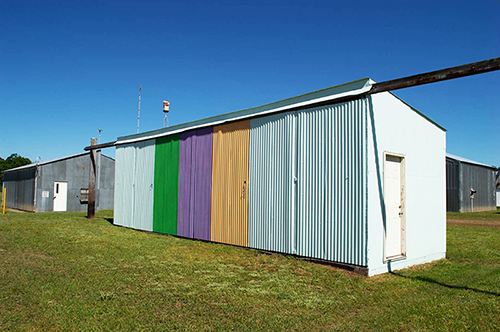
Final Thoughts
One of the most important factors in discussing hangar storage is the local demand. There are many airports in Wisconsin that are out of readily developable hangar lots. Similarly, there are many airports that have long waiting lists for hangar rental space. At a minimum, these airports should be going to great lengths to ensure compliance with the FAA hangar storage policy. In addition, airports with this level of demand may want to consider going above and beyond to ensure the hangars are also being put to their best use.
While hangar storage can be a complex and touchy subject, the Wisconsin Bureau of Aeronautics is here to help. For airports, we can provide hangar lease templates and examples. We can review draft leases and talk through issues related to hangar storage to both airports and tenants alike. If you have hangar storage questions or want help with a specific situation, please feel free to contact me at howard.davis@dot.wi.gov or call 608-267-2142.


















